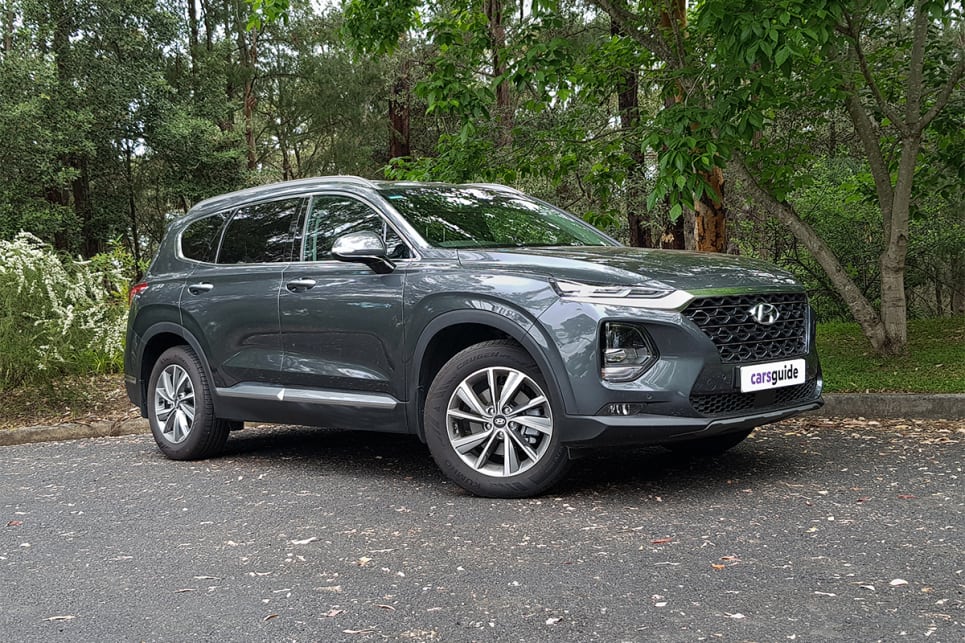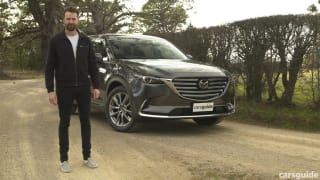Our acceptance of the dual flush toilet is one of the simplest yet smartest adjustments Australia has made in my lifetime. You only use what you need, and everyone benefits.
I’ve also seen the emergence of the SUV, which now sees the versatile, jacked-up wagon bodystyle outnumbering the combined sales of hatchbacks, sedans, wagons coupes and convertibles in Australia. They’re not just a big deal, they are the new face of motoring.
But unlike the handy but simple two toilet buttons, the SUV market has exploded to include at least nine different size classes and sub-categories.
So there’s no point in going for the full flush SUV unless you really need to, and there’s plenty of other options if you don’t.
Since my first child arrived a little over a year and a half ago, I’ve proven you can achieve a whole lot with a mid-size SUV. We started at the smaller end of the mid-size scale with the Tiguan, before the more mainstream Escape, the slightly smaller CX-5, the roomiest-in-class CR-V and then having our cake and eating it with the Golf R wagon.
The arrival of my second baby was made easier with the extra space in the CR-V, but we proved it wasn’t ultimately necessary with the much lower and much faster Golf R wagon.
Plenty of people go straight for a large SUV as soon as #2 is on the horizon though, and I don’t blame them. When you’re ferrying infants, you’ll always find something to fill any gaps you might create by choosing a larger car.
Aside from the often borderline front seat space ahead of a rear-facing baby seat, the most iffy element we’ve identified with carrying two babies is whether Grandma (or a polite parent) is able to sit between two child seats in the back, AND put their seat belt on.
The CR-V had lots of room up the front for my 172cm height ahead of the rear-facing seat and just enough room for a nimble Grandma to access and belt herself in the middle, but the Golf wagon just passed the first test and failed the second.
The CR-V is just right for my family, if equipped with the full suite of safety gear that will still set you back $44,290, but in the interests of making Grandma even happier, the time has come to try something the next size up.
Enter the newest large SUV on the market for the job, with the fourth-generation Santa Fe hitting showrooms just last month.
It’s 174mm longer than the CR-V, 35mm wider, just 1.0mm taller, and rides on a 105mm longer wheelbase, so only really marginally larger despite the Santa Fe being firmly classified as a large SUV unlike the mid-size CR-V.
The Hyundai is, however, 10mm shorter, the same width and 5.0mm lower over a 15mm shorter wheelbase than the Kia Sorento it shares much of its structure and underpinnings with.
Large SUVs certainly get much bigger again, with the Mazda CX-9 for example being 305mm longer, 79mm wider and 67mm taller on a 165mm longer wheelbase than the Santa Fe. So the Hyundai is a good way to go large SUV if you’re feeling a bit nervous about overall size.
Given Richard picked the Elite as the sweet spot of the Santa Fe line-up at its Australian launch, we’ve elected to go with the mid-spec variant for our test. Australia seems to agree too, with Santa Fe sales skewing in favour of the upper end of the range.
The $54,000 (before on-road costs) Elite sits $11,000 and $8000 above the petrol and diesel versions of the base Elite respectively, and $6500 beneath the top-spec Highlander.
The Elite comes standard with leather trim with power front seats, 8.0-inch multimedia screen with built-in sat nav with live traffic updates and lifetime updates, Infinity premium audio, dual-zone climate control, chilled glove box, tinted rear windows, rear window sunshades, proximity keys, front parking sensors, auto wipers, powered tailgate, power folding mirrors with puddle lamps and 18-inch alloys.
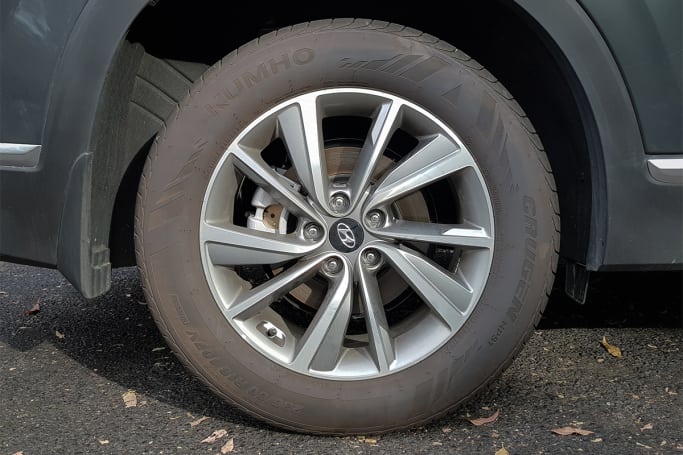
This is on top of the base Active’s Apple CarPlay and Android Auto, active cruise control, reversing camera with rear parking sensors, auto headlights, and front and rear fog lights.
The Elite also comes with the brilliant 'Rear Occupant Alert' (ROA) function, which intends to prevent you from locking the car with a child or animal sitting in the back. A motion sensor in the roof detects movement and a chime will warn the driver when switching off the engine, or honk the horn if the car is locked.
Another safety USP for its class is the Elite’s 'Safe Exit Assist' (SEA) system, which is designed to warn the driver if a vehicle is approaching from the rear to prevent you from opening your door into traffic. It will also prevent the driver from deactivating the rear door child safety lock if an approaching hazard is detected, and there protect rear seat passengers also.
All Santa Fe variants now come with AEB capable of detecting pedestrians and cyclists, along with blind spot warning, rear cross traffic alert, lane keeping assistance, plus active cruise control.
The third row still lacks proper curtain airbag coverage though, designed to cover the window area rather than the rear seat occupants. The new model is also yet to be rated by ANCAP, but is expected to carry over the maximum five star ratings applied to the previous two generations.
The Elite is only available with the 147kW/440Nm 2.2-litre turbo-diesel engine, paired with an eight-speed torque converter auto and Hyundai’s new 'HTRAC' all-wheel drive system. The Elite’s official combined fuel consumption figure is 7.5L/100km.
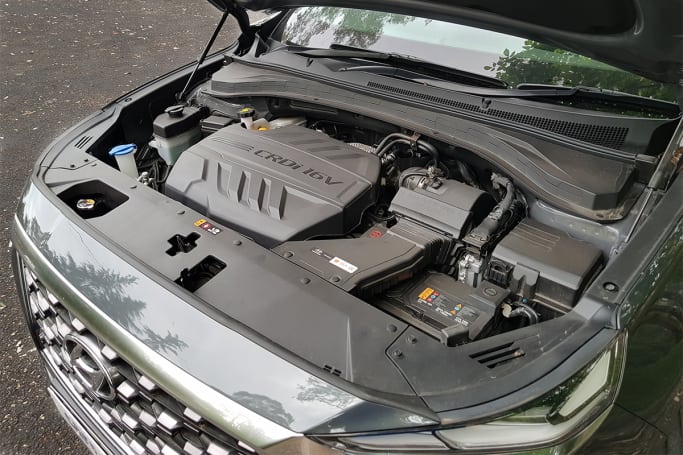
This is the first time my family has lived with a diesel for longer than a week, so we at least look forward to less frequent trips to the servo.
Our Santa Fe Elite story actually started before its launch, with Hyundai offering taste tests of the small Kona and mid-size Tucson before gorging ourselves on the big Santa Fe.
We expected the Tucson to be just right for us with two baby seats, and it was. Enough room up the front ahead of the rearward-facing seat and a generous boot with a full-size spare under the boot floor.
The Kona was more of a walk on the wild side, but we found the front seat space ahead of the babies to be much the same as the Tucson, despite the smaller SUV having a 70mm shorter wheelbase.
The boot was understandably more of a squeeze, but if you loaded it carefully, our twin stroller would fit without interfering with the hatch closing. It did interfere with rearward vision though, so not the ideal solution. For the record, it also easily fit the nappy and snack bag which are essential for day-to-day parenting, and could probably handle a weekend away if we packed our luggage in several smaller soft bags.
So the Santa Fe Elite’s arrival was welcome, and with 1018km on the odo it soon had the two seats ISOFIXed in the back.
Which brings me to our first large SUV busted myth. We’re not likely to get much use from the third row of seats given you can only access them from the boot with two outboard child seats fitted.
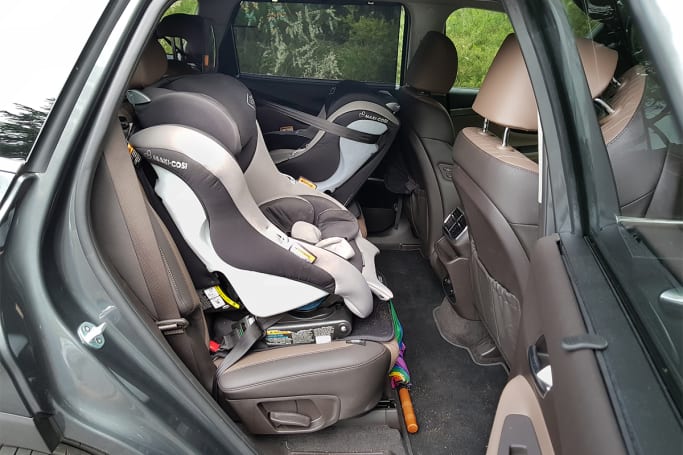
We’ll go into the drive experience in more detail later, but after 1710km of largely urban driving in our first month, the Elite has managed a decent 7.68L/100km of diesel use.
That’s around one litre better than what we’ve seen across the mid-size SUVs we’ve had, but not as significant as you might expect from the completely different fuel type.
Acquired: July 2018
Distance travelled this month: 1710km
Odometer: 2728km
Average fuel consumption for Jul/Aug: 7.68L/100km (measured at the pump)








